#Upper Triassic fossil
Explore tagged Tumblr posts
Photo

RARE Reptile Coprolite with Fish Bones | Upper Triassic Fossil | Aust Cliff Bristol UK | Westbury Formation | Certified Specimen
This listing features a RARE small reptile coprolite fossil with visible fish bone inclusions, discovered from the renowned Aust Cliff locality in Bristol, UK. This exceptional trace fossil comes from the Westbury Formation, part of the Penarth Group, and dates to the Upper Triassic Period, approximately 208–201 million years ago.
Discovered by our team members Alister and Alison on 07 April 2025, this coprolite has been carefully cleaned, prepped, and treated by Alison, ensuring both scientific integrity and display quality.
Geological Context:
Fossil Type: Coprolite (fossilised faeces)
Likely Producer: Small Triassic reptile, possibly a fish-eating sphenodontian or early crocodylomorph
Inclusions: Clearly visible fish bones and scales preserved in matrix
Location: Aust Cliff, Bristol, UK
Formation: Westbury Formation
Group: Penarth Group
Geological Period: Upper Triassic
Depositional Environment: Shallow marine to marginal lagoonal setting with periodic terrestrial input – conducive to fossil preservation of organic-rich material like excrement
Notable Features & Scientific Importance:
This coprolite exhibits remarkable preservation, including bone fragments and fish scale inclusions, providing insight into the diet and ecosystem interactions of Triassic reptiles.
Trace fossils such as this are invaluable for reconstructing palaeoecological dynamics and food webs.
The Aust Cliff site is internationally recognised for its Triassic-Jurassic boundary exposures, yielding important fossils including marine reptiles, invertebrates, and trace fossils.
Palaeontological Classification (trace fossils): While coprolites are classified as ichnofossils (trace fossils) rather than body fossils, their morphological analysis and inclusions allow identification of likely producers and depositional context.
All of our Fossils are 100% Genuine Specimens & come with a Certificate of Authenticity.
Scale cube = 1cm: Please refer to the photo for exact sizing. The fossil shown is the actual specimen you will receive—authentic, ethically sourced, and scientifically prepared.
#coprolite fossil#reptile coprolite#Aust Cliff fossil#Westbury Formation#Penarth Group#Upper Triassic fossil#fish bone coprolite#UK fossil#certified coprolite#genuine Triassic specimen#reptile dung fossil#fossil excretion with inclusions#Alister and Alison fossil find
0 notes
Text
Round 3 - Chondrichthyes - Chimaeriformes




(Sources - 1, 2, 3, 4)
Our last order in Chondrichthyes is Chimaeriformes, commonly known as “Chimaeras”, and informally known as “ghost sharks”, “spookfish”, “rabbitfish”, or “rat fish” (not to be confused with the Actinopterygiian “rattails”.) Historically a much more diverse and abundant group, they now only comprise the living families Callorhinchidae (“plough-nosed chimaeras” or “elephantfish”), Chimaeridae (“short-nosed chimaeras”), and Rhinochimaeridae (“long-nosed chimaeras”).
Chimaeras are soft-bodied, with bulky heads and long, tapered tails. Their pectoral fins are large enough to generate lift at a relaxed forward momentum, similar to a kite, giving the chimaera the appearance of "flying" through the water. Their gill arches are condensed into a pouch-like bundle covered by an operculum with a single gill-opening in front of the pectoral fins, similar in appearance to Actinopterygiians. They lack spiracles. There are two dorsal fins: a large triangular first dorsal fin and a low rectangular or depressed second dorsal fin. For defense, some chimaeras have a venomous spine on the front edge of the dorsal fin. In many species, the bulbous snout is modified into an elongated sensory organ, capable of electroreception to find prey. Instead of many sharp, consistently-replaced teeth, chimaeras have just six large, permanent tooth-plates, which grow continuously throughout their entire life. These tooth-plates are arranged in three pairs, with one pair at the tip of the lower jaws and two pairs along the upper jaws. They together form a protruding, beak-like crushing and grinding mechanism, comparable to the incisor teeth of rodents and lagomorphs. Most living species are native to the deep sea, with some species inhabiting depths exceeding 2,000 m (6,600 ft) deep, though the few exceptions include the shallower-dwelling plough-nosed chimaeras (genus Callorhinchus) (image 2), the Rabbit Fish (Chimaera monstrosa), and the Spotted Ratfish (Hydrolagus colliei) (image 3).
Chimaeras have separate anal and urogenital openings, rather than a single cloaca. Like sharks and rays, male chimaeras utilize claspers for internal fertilization of females, but unlike sharks and rays, also have retractable sexual appendages known as tentacula to assist in mating. The frontal tentaculum, a bulbous rod which extends out of the forehead, is used to clutch the females' pectoral fins during mating. The prepelvic tentacula are serrated hooked plates normally hidden in pouches in front of the pelvic fins, and they anchor the male to the female. Their claspers are fused together by a cartilaginous sheathe before splitting into a pair of flattened lobes at their tip. Females lay their eggs within spindle-shaped, leathery egg cases which they deposit on the sea floor.
As the most ancient of the Chondrichthyans, Chimaeriformes are truly deserving of the moniker “living fossil”. They have been around since the Early Carboniferous, with the earliest known fossil species being Protochimaera, and split off from the sharks and rays during the Devonian. Modern chimaeras are known from the Early Jurassic, but fossil egg cases from the Late Triassic resembling those of rhinochimaerids and callorhinchids indicate that they had a global distribution earlier than this. Modern chimaeras reached their highest ecological diversity during the Middle Cretaceous. Recent studies indicate that chimaeras were likely a shallow-water group for most of their existence, and only fled to deeper waters in the aftermath of the K-Pg extinction event, adapting to the deep sea to survive.

Propaganda under the cut:
Some chimaera venom can cause pain, necrosis, hallucinations, and localized paralysis in humans. It is not deadly to humans, but has been known to kill Harbor Seals that injested Spotted Ratfish (Hydrolagus colliei).
Spotted Ratfish (Hydrolagus colliei) have large, emerald green eyes, which are able to reflect light, similar to the eyes of a cat.
Chimaera teeth are unique among vertebrates, due to their mode of mineralization. Most of each plate is formed by relatively soft osteodentin, but the active edges are supplemented by a unique hypermineralized tissue called pleromin, rather than enamel. Pleromin is an extremely hard enamel-like tissue, arranged into sheets or beaded rods, but it is deposited by mesenchyme-derived cells similar to those that form bone. In addition, pleromin's hardness is due to the mineral whitlockite, which crystalizes within the teeth as the animal matures.
The Australian Ghostshark (Callorhinchus milii) is very popular with fish-and-chips restaurants in New Zealand and is sold as 'flake' or 'whitefish' in Australia.
The Striped Rabbitfish (Hydrolagus matallanasi) can see in total darkness and sense electromagnetic radiation (outside of the visible spectrum) emitted by other marine creatures due to exposed nerves on the sides of its body.
Some species of chimaerids are known to segregate by sex, with females congregating at greater depths than males.
Despite their deep sea habitat and reclusive nature, some chimaera species are still threatened by bycatch due to deep sea trawling for demersal shrimp and prawns. Even when released, most chimaeras do not survive the process of being quickly pulled up from the pressurized deep sea to shallower water.
#description a bit longer than usual because they’re so unlike all the other members of the class#animal polls#round 3#chondrichthyes
102 notes
·
View notes
Text
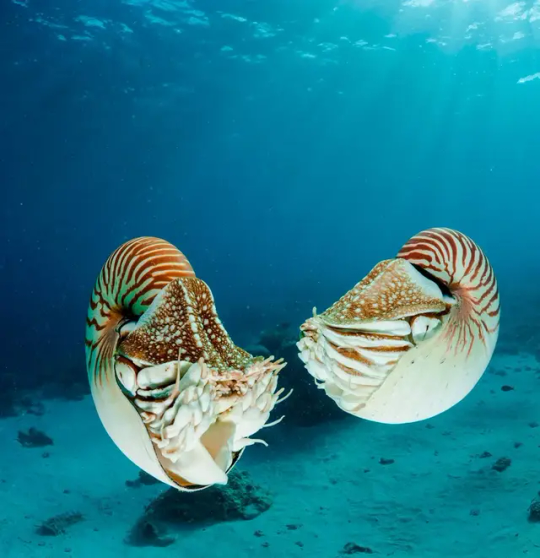

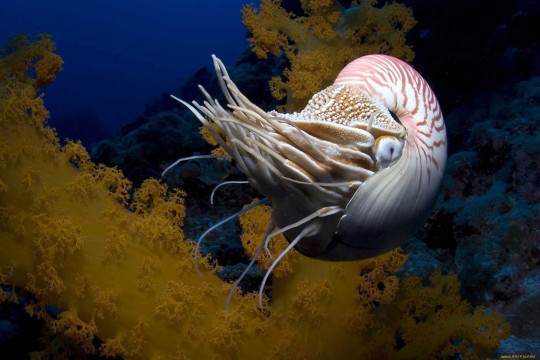
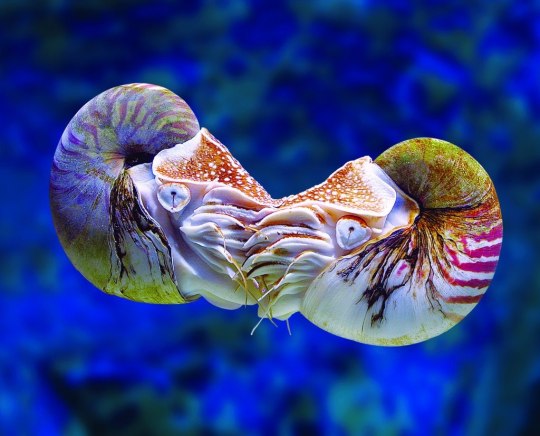
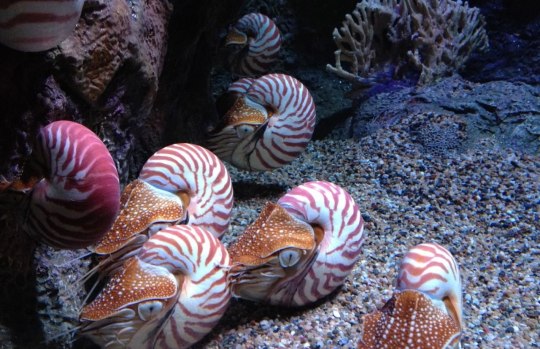
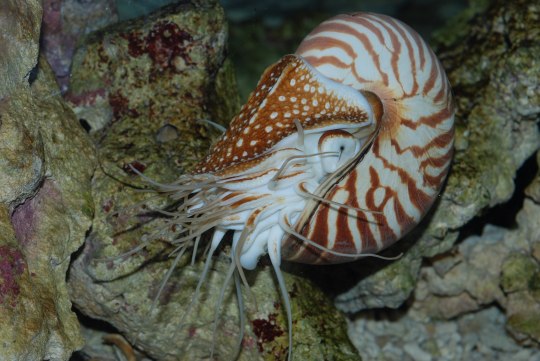
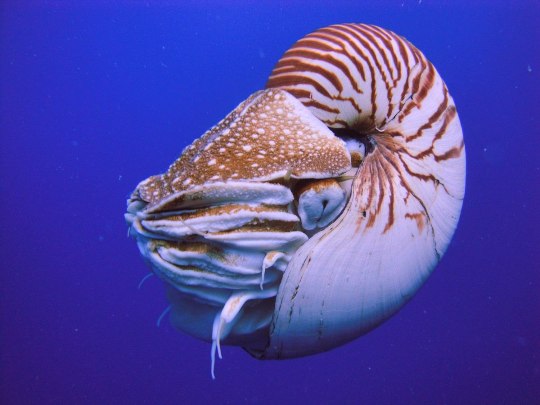
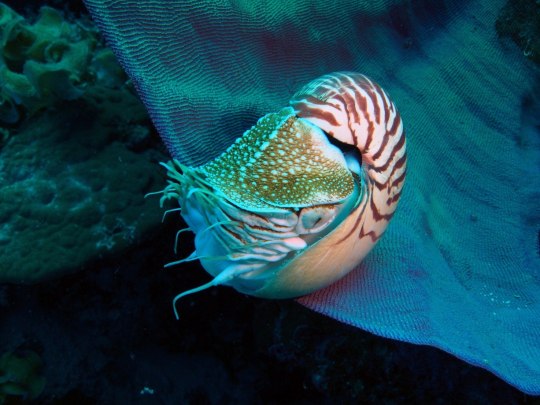




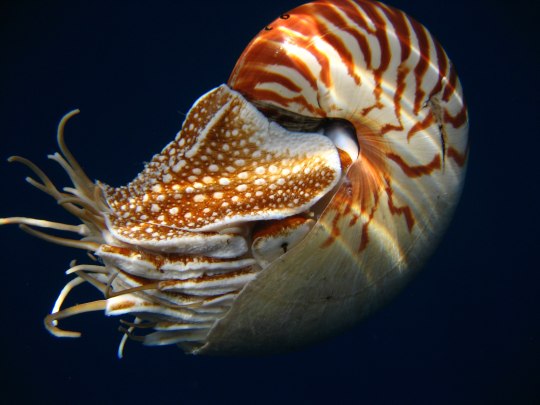
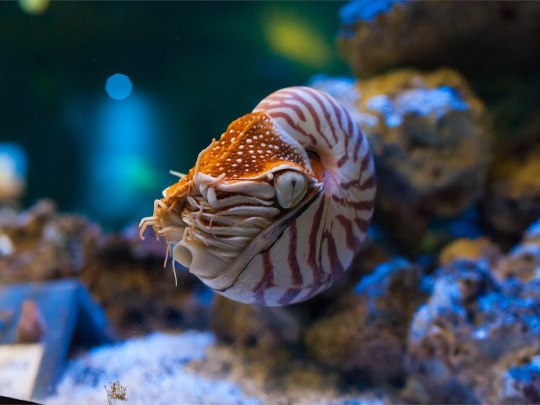
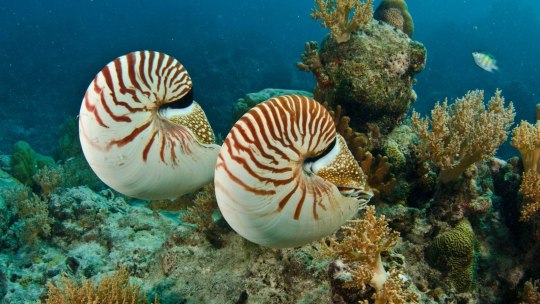
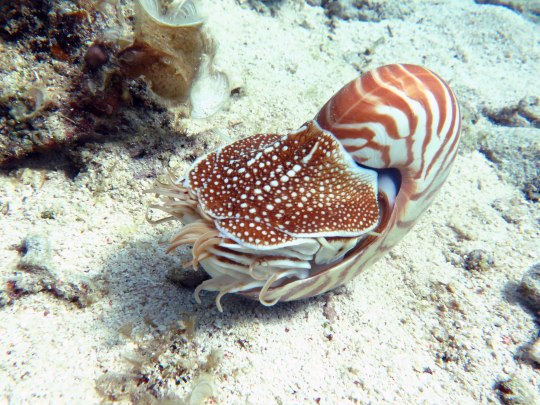
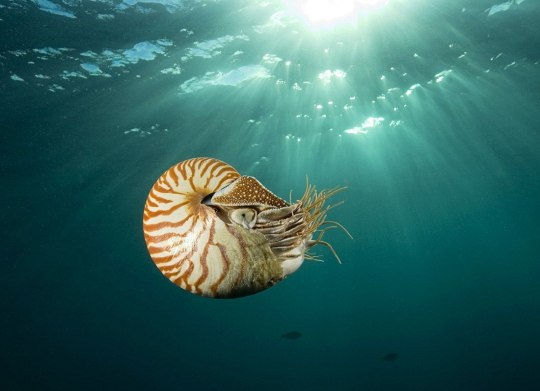

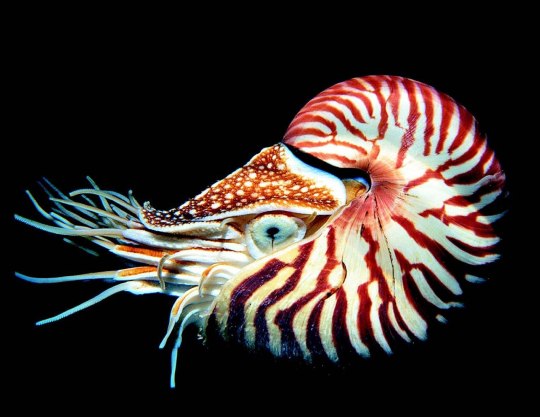

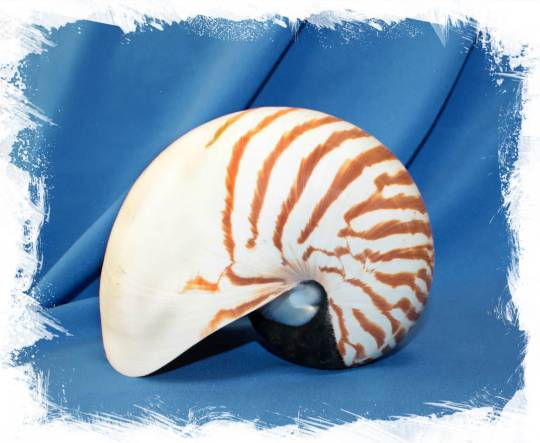
Наутилус (лат. Nautilus) — род головоногих моллюсков, которых относят к «живым ископаемым». Самый распространенный вид — Nautilus pompilius. Наутилусы относятся к единственному современному роду подкласса наутилоидей. Первые представители наутилоидей появились в кембрии, а его развитие пришлось на палеозой. Наутилиды почти вымерли на границе триаса и юры, но все же дожили до наших дней, в отлич��е от своих родственников аммонитов. Некоторые виды древних наутилусов достигали размера в 3,5 м. Представители самого крупного вида современных наутилусов достигают максимального размера в 25 см.
Спиральный «домик» моллюска состоит из 38 камер и «построен» по сложному математическому принципу (закон логарифмической прогрессии). Все камеры, кроме последней и самой большой, где размещается тело наутилуса с девятью десятками «ног», соединяются через отверстия между собой сифоном. Раковина наутилуса двухслойная: верхний (наружный) слой – фарфоровидный – действительно напоминает хрупкий фарфор, а внутренний, с перламутровым блеском – перламутровый. «Домик» наутилуса растет вместе с хозяином, который перемещается по мере роста раковины в камеру попросторней. Пустое жилище моллюска после его гибели можно встретить далеко от его места обитания – после гибели «хозяина» их раковины остаются на плаву и перемещаются по воле волн, ветров и течений.
Интересно, что двигается наутилус «в слепую», задом наперед, не видя и не представляя препятствий, которые могут оказаться на ��го пути.И еще одно удивительное качество этих древних обитателей Земли – у них потрясающая регенерация: буквально через несколько часов раны на их телах затягиваются, а в случае потери щупальца быстро отрастает новое.
Nautilus is a genus of cephalopods, which are classified as "living fossils". The most common species is Nautilus pompilius. Nautilus belong to the only modern genus of the Nautiloid subclass. The first representatives of the Nautiloids appeared in the Cambrian, and its development took place during the Paleozoic. The Nautilids almost died out on the border of the Triassic and Jurassic, but still survived to the present day, unlike their Ammonite relatives. Some species of ancient Nautilus reached a size of 3.5 m. Representatives of the largest species of modern nautilus reach a maximum size of 25 cm.
The spiral "house" of the mollusk consists of 38 chambers and is "built" according to a complex mathematical principle (the law of logarithmic progression). All chambers, except the last and largest, where the nautilus body with nine dozen "legs" is located, are connected through holes with a siphon. The nautilus shell is two–layered: the upper (outer) layer – porcelain–like - really resembles fragile porcelain, and the inner, with a mother-of-pearl luster - mother-of-pearl. The nautilus's "house" grows with its owner, who moves as the shell grows into a larger chamber. The empty dwelling of a mollusk after its death can be found far from its habitat – after the death of the "owner", their shells remain afloat and move at the will of waves, winds and currents.
Interestingly, the Nautilus moves "blindly", backwards, without seeing or imagining the obstacles that may be in its path.And another amazing quality of these ancient inhabitants of the Earth is that they have amazing regeneration: in just a few hours, the wounds on their bodies heal, and in case of loss of tentacles, a new one grows quickly.
Источник:://t.me/+t0G9OYaBjn9kNTBi, /sevaquarium.ru/nautilus/, /habr.com/ru/articles/369547/, //wallpapers.com/nautilus, poknok.art/6613-nautilus-molljusk.html, //wildfauna.ru/nautilus-pompilius, /www.artfile.ru/i.php?i=536090.
#fauna#video#animal video#marine life#marine biology#nature#aquatic animals#cephalopods#Nautilus#nautilus pompilius#living fossils#ocean#benthic#coral#plankton#beautiful#animal photography#nature aesthetic#видео#фауна#природнаякрасота#природа#океан#бентосные#головоногие моллюски#Наутилус#живое ископаемое#коралл#планктон
187 notes
·
View notes
Text
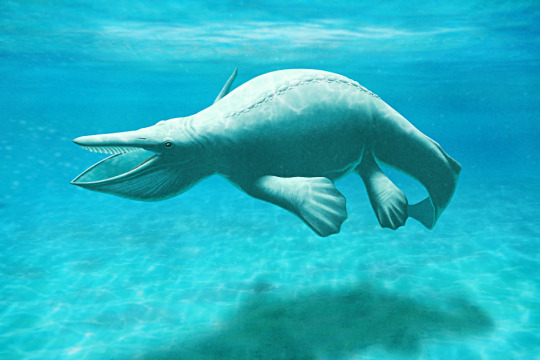
Hupehsuchians were small marine reptiles closely related to ichthyosaurs, known only from the Early Triassic of southwestern China about 249-247 million years ago. They had toothless snouts, streamlined bodies, paddle-like limbs, and long flattened tails, along with a unique pattern of armor along their backs made up of overlapping layers of bony osteoderms.
Hupehsuchus nanchangensis was a mid-sized member of the group, about 1m long (3'3"). Newly-discovered fossils of its skull show that its long flattened snout had a distinctive gap between the bones (similar to the platypus-like snout seen in its relative Eretmorhipis) with an overall shape surprisingly convergent with that of modern baleen whales – suggesting that this hupehsuchian may have been a similar sort of filter-feeder.
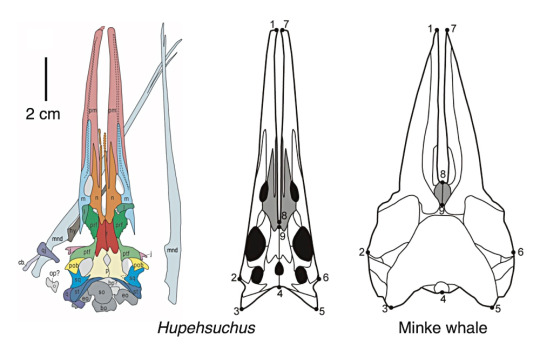
Hupehsuchus skull compared to a modern minke whale [From fig 2 & fig 3 of Fang et al (2023). First filter feeding in the Early Triassic: cranial morphological convergence between Hupehsuchus and baleen whales. BMC Ecol Evo 23, 36. https://doi.org/10.1186/s12862-023-02143-9]
Grooves in the bones along the outer edges of its upper jaws may be evidence of filtering structures similar to baleen, although with no soft-tissue preservation we don't know exactly what this would have looked like. Its slender flexible lower jaws probably also supported a large expandable throat pouch, allowing it to filter plankton out of larger volumes of water.
———
NixIllustration.com | Tumblr | Patreon
#science illustration#paleontology#paleoart#palaeoblr#hupehsuchus#hupehsuchia#ichthyosauromorpha#reptile#marine reptile#art#triassic weirdos
603 notes
·
View notes
Text
FOSSIL FRIDAY: Ceratites
Ceratitida is an order of ammonite from the upper Permian through the Triassic Period.

They are identified by the smooth saddle and serrated lobe suture patterns.

They are found in Europe, the Middle East, Russia, China, Papua New Guinea and the Great Basin of the western U.S. Essentially, the coastlines of Pangea.

MORPHOLOGY AND ECOLOGY
It is thought that the frilly, serrated lobes in the sutures evolved due to increased water pressure on shells. This implies that these ammonites, while still living in shallow seas, ventured out into deeper water in search of food.
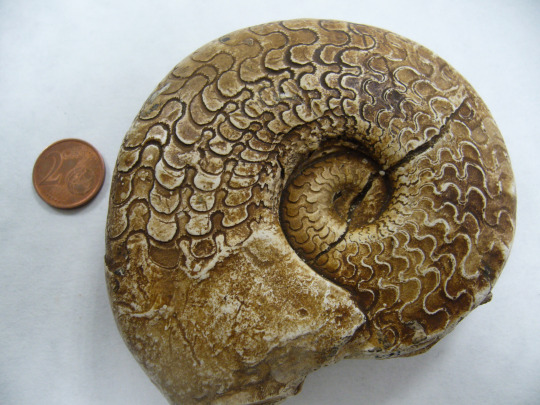
59 notes
·
View notes
Text
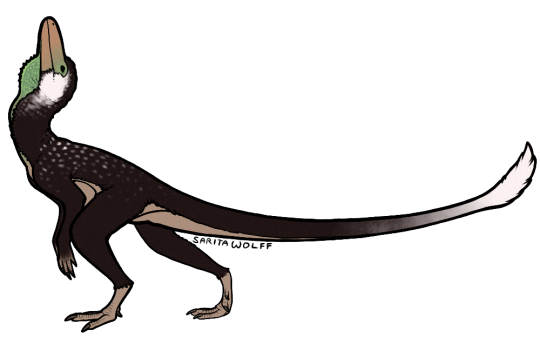
#Archovember Day 26 - Ixalerpeton polesinensis
The Triassic lagerpetids were once thought to be early dinosauromorphs, but recent fossil evidence suggest that they were actually pterosauromorphs… either closely related to pterosaurs or even ancestral to them! Ixalerpeton polesinensis was a lagerpetid from Late Triassic Brazil, a locale that would eventually become a hotspot for pterosaurs. Like other lagerpetids, it had long hind legs with well-developed muscles, but it lacked the neural spines that suggest hopping locomotion as in Lagerpeton. It was small and agile, likely using its long legs to chase and leap after insects.
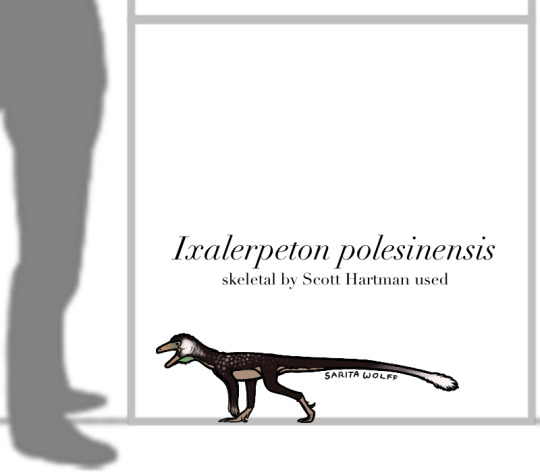
In the Upper Santa Maria Formation, Ixalerpeton would have had to watch out for large predatory pseudosuchians like Rauisuchus and herrerasaurids like Staurikosaurus and Gnathovorax. It also lived alongside early aetosaurs Aetobarbakinoides and Aetosauroides, silesaurs like Amanasaurus, and basal sauropodomorphs Buriolestes and Saturnalia. There were also a variety of cynodonts, like Gomphodontosuchus and Prozostrodon, and the temnospondyl amphibian Compsocerops.
#my art#SaritaDrawsPalaeo#Ixalerpeton polesinensis#Ixalerpeton#lagerpetid#pterosauromorphs#archosaurs#archosauromorphs#reptiles#Archovember#Archovember2023
20 notes
·
View notes
Text
Vertebrates 2/24
today in verts we talked about turtles. apparently, turtles have a lot going on that make them super freaky when it comes to their sister taxa.
Lets start with this question: What exactly ARE turtles?
Order Testundies
Sauropsida
Only 361 alive species across 14 families
Instantly recognizeable because of shell
What is so weird about them?
Turtles have anapsid skulls, and are the only amniotes (vertebrates that lay amniotic eggs) with this condition
What is an anapsid skull?
Anapsid skull is a type of Temporal Fenestration.
Temporal fenestrae are openings in the skull that are behind the eyes which allow movement of the lower jaw.
Anapsid means no fenestra, so the only opening are the orbits (eye holes) and nostrils. (turtles)
Synapsid means single fenestra, which is the lower fenestra. (this is what humans have, including mammals and mammal like reptiles)
Diapsid means two fenestrae, which are upper and lower. (lepidosaurs and archosaurs [lizards/snakes, crocodiles/dinosaurs/birds, respectively])
The big question with turtles anapsid skulls is: were they always this way, or did they lose their synapsid/diapsid condition?
The answer comes from the fossil record. In the past we can see that the synapsid condition appears in turtles once in the synapsid lineage, and the diapsid condition appears once in the sauropsid lineage. This proves that turtles evolved to have the anapsid condition in their skull, making it a secondary condition.
2. Modern turtles lack teeth
Jaws of turtles are surrounded by a hard keratinous sheath. Keratin is the same thing our fingernails are made of, but this is a much thicker and denser makeup of it. It has a very sharp beaklike shape that is good for cutting plant and animal material. This is good, because most turtles are omnivores or carnivores.
There are some turtles that are herbivores, but these are usually stenophagous (specific diet) and only eat a certain food in general.
3. Modern turtles are divided into two groups
Cryptodira
262/361 species belong here
head retracts as a vertical S-bend
known as "S-necked" turtles
found in fresh water, marine, and terrestrial
Pleurodira
99/361 species belong here
head retracts by bending horizontally into shell
known as "side-necked" turtles
All freshwater
4. Turtle Shells
Formed by 3 elements
Endoskeleton (spine, ribs, clavical)
Exoskeleton (dermis)
Epidermis (keratinous scutes)
Two halves of shell are:
carapace (top)
plastron (bottom)
The carapace is covered in scutes, which are the individual outlined shapes on top. Under the carapace is bone, dermal and endochondral. Dermal bone is the lower layer and endochondral is the upper layer.
Now lets talk about the types of shells:
Hinged shell
Hinge in the middle that allows the plastron to close the front and back opening of the shell
OR
Double hinge on either end
Weird shells
Lack keratinous scutes and bony plates are reduced
OR
Lack keratinous scutes and the bony plates are replaced by thousands of dermal bone
Evidence of turtles date back to the triassic period
5. How do turtles breathe?
Before getting into this, it is important to note that during development, turtles ribs fuse to their shell, which is good because it reinforces their shell, but it also changes how they breathe in comparison to other amniotes.
Amniotes use a process called costal ventilation, which is where when the lungs expand with air, the ribcage moves with it, and then when the lungs exhale, the ribcage goes back to normal. Because turtles cannot move their fused ribcage, they had to adapt a new way of breathing.
Instead of moving their lungs, turtles move their guts!
when the turtle inhales, the lungs expand. a few muscles and membranes surrounding the guts stretch and allow the lungs to push their gut downward
when the turtle exhales, the muscles and membranes push the guts back up towards the deflating lungs
This causes problems for many turtles functions.
when a turtle is fully retracted inside of its shell, it cannot breathe and must hold its breath
Sea turtles cannot breathe when they walk. they must walk, then take a break to breathe
Most turtles can breathe when they walk due to their diagonal gait. They walk with their left back foot and right front foot, and then right back foot and left front foot.
Aquatic turtles must come up for air, which makes them vulnerable to predators. Luckily, they can hold their breath for a very long time.
There is another way for turtles to breathe which is honestly pretty funny. I'm being completely serious when I tell you, some of them can breathe through their buttholes. They literally open their butthole over and over and pump water in and out and are able to diffuse oxygen from the water. This is really good for them to not have to surface, especially for turtles who get trapped under ice in colder months.
6. Turtle reproduction!
Lay on average 4-5 eggs, or even up to 100 eggs!
Almost no parental care, layed egg and then you are on your own!
Temperature dependent sex determination (TSD):
temperature determines sex of turtle. (Humans are the organism with gender, everything else is sorted by sex)
changes of even 3-4 degrees can determine sex
Lower temps mean males while higher temps mean females
Challenges of reproduction:
Few eggs and slow maturity mean turtles do not reproduce fast enough to combat endangerment
Pet trading, food collection, medicine, habitat destruction, and pollution all affect turtles
Global warming effects TSD and creates a disproportionate ratio of sexes which affects future reproduction as well
Over half of the 361 species are endangered
In conclusion, turtles are funky. We need to protect them to ensure they stay on our earth!
3 notes
·
View notes
Text
Triassic Double Feature
Just weeks ago I remissed the lack of new croc taxa, seems I spoke to soon because they are being pumped out like crazy right now. For simplicity, I will cover two of the recent sorta-crocs together as neither are super extensive and they match in overall time.
These two new genera are the aetosaur Kryphioparma and the phytosaur Jupijkam. Pictured below the fossils of both with reconstructions of close relatives (art by Brian Engh and Gabriel Ugueto).
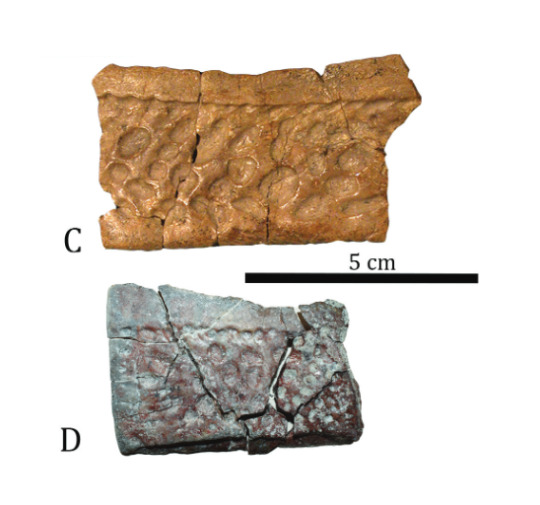

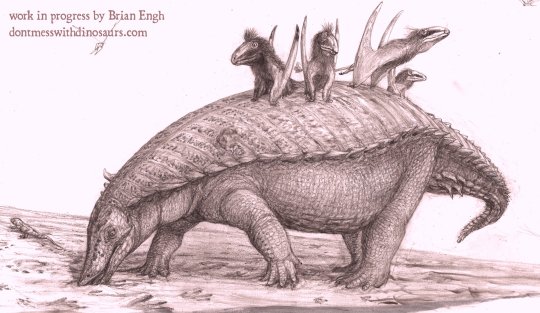

I'll start with Kryphioparma, which I wager is the less interesting of the two. Kryphioparma was an aetosaur, which are effectively early pseudosuchians that evolved a body type very similar to what nodosaurs did later. Heavily armored, sometimes with prominent spikes and herbivorous.
Kryphioparma is only known from four isolated and incomplete osteoderms, and though these are actually diagnostic and highly distinct, it does mean there's not super much to say. Hell, the scientific name literally means "mysterious shield" in reference to how little we know.
Regardless, scientists did determine two things. 1) It's a typothoracine aetosaur, narrowing down its placement to one of the two main branches. This means its closer related to Typothorax (with its armored cloaca) than to Desmatosuchus (with its shoulder spikes). 2) The second thing we know is that it wasn't alone. No, the localities that yielded its bones (Placerias Quarry and Thunderstorm Ridge) actually preserve a highly diverse aetosaur fauna, including Calypsosuchus, Tecovasuchus and two species of Desmatosuchus. All images by Jeff Martz.

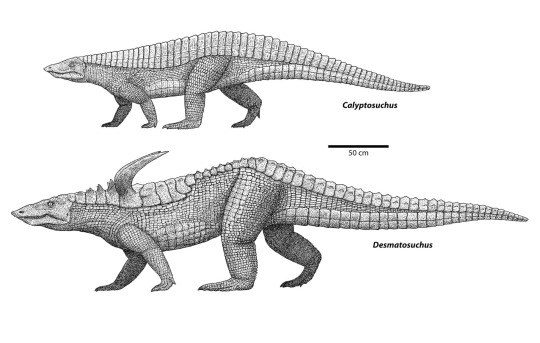
Now the arguably more exciting find is that of Jupijkam, a type of phytosaur, which are archosaurs superficially resembling today's crocodiles. Now when I grew up, phytosaurs used to be considered to be entirely unrelated to crocs, being a type of archosaur believed to have diverged prior to the bird-croc split. However, it would appear that recent studies suggest that they could actually be true croc-line archosaurs, potentially being the earliest diverging group of Pseudosuchian.
Jupijkam is from the Rhaetian-Norian Blomidon Formation of Novia Scotia, Canada. This not only makes it one of the youngest, but also one of the northern-most known phytosaurs to date. It's scientific name, Jupijkam, is actually derived from the name given by the local Mi’kmaq people to their version of the horned serpent.
How Jupijkam is related to other phytosaurs is a bit wonky. Now generally, its recovered as a mystriosuchine, which isn't exactly a surprise given that most phytosaurs fall into this category. It's placement however shifts ever so slightly depending on the precise methods and characters used. 2/4 times it was found to be most closely related to Rutiodon (the phytosaur shown at the very start), once alongside the Indian Volcanosuchus and once to its exclusion. One tree simply results in a big polytomy which isn't really helpful, and one time it was found as a much more derived form related to Mystriosuchus. Whatever the case, additional finds both of other phytosaurs and Jupijkam specifically might clarify this in the future. Currently however, it seems that this form is not related to all the other American species of its time, suggesting it held out till the late Triassic independently. Which is pretty neat. Below you can see a comparisson between Jupijkam and some other slender-snouted phytosaurs, courtesy of Brownstein 2023. A is Jupijkam, B is Rutiodon and C is Machaeroprosopus

Really that wraps things up already, two new genera, both Triassic, both (potentially) early Pseudosuchians. A little bit out of my usual focus but very interesting none the less. Definitely gotta make another post soon since they just dropped yet another new one (a metriorhynchid), but I gotta read that paper first. Speaking of which A new aetosaur (Archosauria: Pseudosuchia) from the upper Blue Mesa Member (Adamanian: Early–Mid Norian) of the Late Triassic Chinle Formation, northern Arizona, USA, and a review of the paratypothoracin Tecovasuchus across the southwestern USA (escholarship.org) A late-surviving phytosaur from the northern Atlantic rift reveals climate constraints on Triassic reptile biogeography | BMC Ecology and Evolution | Full Text (biomedcentral.com) plus the respective Wikipedia pages Kryphioparma - Wikipedia Jupijkam - Wikipedia
#pseudosuchia#phytosaur#aetosaur#croc#palaeoblr#paleontology#prehistory#triassic#chinle formation#Kryphioparma#Jupijkam#long post#science#reptiles
40 notes
·
View notes
Text
On a skeletally immature individual of Unaysaurus tolentinoi (Dinosauria: Sauropodomorpha) from the upper Triassic of southern Brazil
Published 6th July 2023
Study and identification of a fossil found in association with the Unaysaurus tolentinoi holotype revealed to belong to a junvenile of the same species.
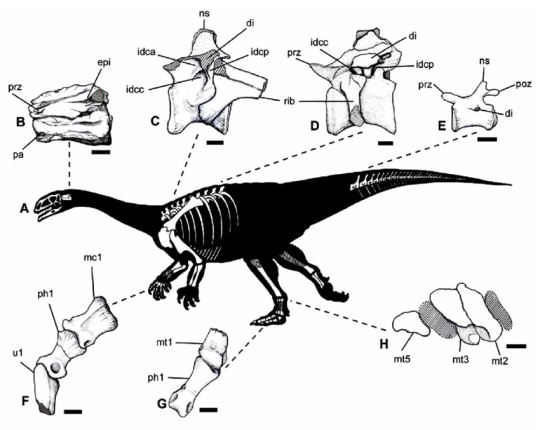
Skeletal reconstruction of Unaysaurus tolentinoi based on a 2004 study
Source:
https://doi.org/10.1002/ar.25285
4 notes
·
View notes
Text
From Peasant Fodder To Posh Fare: How Snails And Oysters Became Luxury Foods
— Beth Daley | The Conversation | May 22, 2025

An Oyster cellar in Leith. John Burnet, 1819; National Galleries of Scotland, Photo: Antonia Reeve
Oysters and escargot are recognised as luxury foods around the world – but they were once valued by the lower classes as cheap sources of protein. Less adventurous eaters today see snails as a garden pest, and are quick to point out that freshly shucked oysters are not only raw but also alive when they are eaten. How did these unusual ingredients become items of conspicuous consumption?
From Garden Snail To Gastronomy
Eating what many consider to be a slimy nuisance seems almost counter-intuitive, but consuming land snails has an ancient history, dating to the Palaeolithic period, some 30,000 years ago in eastern Spain. Ancient Romans also dined on snails, and spread their eating habits across their empire into Europe. Lower and middle class Romans ate snails from their gardens, while elite consumers ate specially farmed snails, fed spices, honey and milk.

An Ancient Roman mosaic dating to the 4th century AD depicting a basket of snails, Basilica di Santa Maria Assunta, Aquileia, Italy. Carole Raddato/Wikimedia Commons, CC BY-SA
Pliny the Elder (AD 24–79) described how snails were raised in ponds and given wine to fatten them up. The first French recipe for snails appears in 1390, in Le Ménagier de Paris (The Good Wife’s Guide), but not in other cookbooks from the period.
In 1530, a French treatise on frogs, snails, turtles and artichokes considered all these foods bizarre, but surprisingly popular. Some of the appeal had to do with avoiding meat on “lean” days. Snails were classified as fish by the Catholic Church, and could even be eaten during Lent.
For the next 200 years, snails only appeared in Parisian cookbooks with an apology for including such a disgusting ingredient. This reflected the taste of upper-class urbanites, but snails were still eaten in the eastern provinces.

Schneckenweib, or Snail Seller, illustrated by Johann Christian Brand in Vienna, after 1798. Wien Museum
An 1811 cookbook from Metz, in the Alsace region in northeastern France, describes raising snails like the Romans, and a special platter, l'escargotière, for serving them. The trend did not travel to Paris until after 1814.
French diplomat Charles-Maurice de Talleyrand-Périgord (1754–1838) hosted a dinner for Russian Tsar Alexander I, after he marched into Paris following the allied forces’ defeat of Napoleon in 1814. The chef catering the meal was the father of French cuisine Marie-Antoine Carême, a native of Burgundy, spiritual home of the now famous escargots de Bourgogne.
Carême served the Tsar what would become a classic recipe, prepared with garlic, parsley and butter. Allegedly, the Tsar raved about the “new” dish, and snails became wildly popular. A recipe for Burgundy snails first appeared in a French culinary dictionary published in 1825.
It is ironic that it took the approval of a foreign emperor, who had just conquered Napoleon, to restore luxury status to escargot, a food that became a symbol of French cuisine. Snails remain popular today in France, with consumption peaking during the Christmas holidays, but May 24 is National Escargot Day in France.
Oysters: The Original Fast Food
Oysters are another ancient food, as seen in fossils dating to the Triassic Era, 200 million years ago. Evidence of fossilised oysters are found on every major land mass, and there is evidence of Indigenous oyster fisheries in North America and Australia that dates to the Holocene period, about 12,000 years ago.
There are references in classical Greek texts to what are probably oysters, by authors like Aristotle and Homer. Oyster shells found at Troy confirm they were a favoured food. Traditionally served as a first course at banquets in Ancient Greece, they were often cooked, sometimes with exotic spices.

Music-cover sheet for ‘Bonne-Bouche’ by Emile Waldteufel, 1847-1897. © The Trustees of the British Museum, CC BY-NC-SA
Pliny the Elder refers to oysters as a Roman delicacy. He recorded methods of the pioneer of Roman oyster farming, Sergius Orata, who brought the best specimens from across the Empire to sell to elite customers.
Medieval coastal dwellers gathered oysters at low tide, while wealthy inland consumers would have paid a premium for shellfish, a perishable luxury, transported to their castles.
French nobles in 1390 preferred cooked oysters, roasted over coals or poached in broths, perhaps as a measure to prevent food poisoning. As late as the 17th century, authors cautioned:
But if they be eaten raw, they require good wine […] to aid digestion.

Oyster Seller, Jacob Gole, 1688–1724. Rijksmuseum
By the 18th century, small oysters were a popular pub snack, and larger ones were added as meat to the stew pot. That century, it is believed as many as 100,000 oysters were eaten each day in Edinburgh and the shells from the tavern in the basement filled in gaps in the brickwork at Gladstone’s Land in Edinburgh’s Royal Mile.
Scottish oyster farms in the Firth of Forth, an inlet of the North Sea, produced 30 million oysters in 1790, but continual over-harvesting took its toll. By 1883 only 6,000 oysters were landed, and the population was declared extinct in 1957.
As wild oyster stocks dwindled, large oyster farms developed in cities like New York in the 19th century. Initially successful, they were polluted, and infected by typhoid from sewage. An outbreak in 1924 killed 150 people, the deadliest food poisoning in United States history.

Costumes of Naples: Oyster Sellers, c. 1906–10. Rijksmuseum
Far from the overabundance of oysters we once had, over-fishing, pollution, and invasive species all threaten oyster populations worldwide today. Due to this scarcity of wild oysters and the resources required to safely farm environmentally sustainable oysters, they are now a premium product.
Next On The Menu
Scarcity made oysters a luxury, and a Tsar’s approval elevated snails to gourmet status. Could insects become the next status food? Ancient Romans ate beetles and grasshoppers, and cultures around the world consume insects, but not (yet) as luxury products. Maybe the right influencer can make honey-roasted locust the next species to jump from paddock to plate.
#TheConversation.Com#Beth Daley | Executive Editor ✍️ | General Manager#Peasant Fodder#Posh Fare#Snails 🐌🐌🐌#Oysters 🦪🦪🦪#History#Food 🍲🍱🥘#Food History
0 notes
Text
#2773 - Pleurotomaria hectori - Slit Snail

The most common member of a large extinct genus found in Triassic rocks from New Zealand and New Caledonia. It's been found from the Oretian (early Late Triassic) to Otapirian (latest Triassic) stages - 227-201Mya.
They're found with nearshore brachiopod and molluscan fossils, in fine-to coarse-grained sandstone. That suggests they lived in shallow shelf environments, although since the K-T mass extinction the surviving Pleurotomariids all live on the outer continental shelf to the upper bathyal deeps.
Pleurotomariids are a very old snail family, and haven't changed much since the Cambrian. They have a long narrow notch running back from the mouth of the shell, that is used as a an exhalant opening. They feed on sponges, crinoids and octocorals, and protect themselves from their own predators by secreting a white fluid.
University of Otago Geology Museum, Dunedin, Aotearoa New Zealand.
#University of Otago Geology Museum#Dunedin#Dunedin NZ#Pleurotomariidae#Pleurotomaria#new zealand fossil#fossil#slit snail
0 notes
Photo

Ceratodus Fossil Coprolites – Upper Triassic – Aust Cliff, Westbury Formation, UK – Authentic Specimen
Ceratodus Coprolite Fossils in Matrix – Upper Triassic – Aust Cliff, Westbury Formation, Penarth Group, Bristol, UK
This listing features a genuine fossil coprolite specimen, attributed to the prehistoric lungfish Ceratodus, embedded in original matrix from the famous fish, reptile, and coprolite bed at Aust Cliff, near Bristol. This site is part of the Westbury Formation, a classic Upper Triassic locality in the UK known for its rich vertebrate fossil content.
Scientific & Geological Details:
Location: Aust Cliff, Bristol, England, UK
Formation: Westbury Formation
Group: Penarth Group
Age: Upper Triassic (~205–210 million years ago)
Depositional Environment: Lagoonal to marginal marine with periodic anoxic conditions—ideal for preservation of vertebrate remains and trace fossils
Fossil Zone: Part of the Rhaetian Stage, marking the transition to the Jurassic
Notable Species: Ceratodus was a genus of lungfish, a group that still survives today in limited forms. These fish were adapted to low-oxygen waters and left behind spiral or pellet-like faecal fossils.
Morphological Features of the Coprolite:
Typically cylindrical or spiral in form
Surface texture may show subtle spiral markings (if not abraded)
Matrix may contain associated microvertebrate remains including fish scales or bone fragments
Represents trace fossil evidence (not the animal itself but its biological activity)
Specimen Information:
Discovery Date: 07 April 2025
Collected By: UKGE team members Alister and Alison
Preparation: Expertly cleaned and stabilised by Alison
Scale Reference: Shown alongside a 1cm cube for exact sizing – see photographs for dimensions and angles
What You See Is What You Get: The photos show the exact item you will receive
Authenticity: Supplied with a Certificate of Authenticity. All our fossils are 100% genuine and responsibly sourced.
Educational and Collectible Value:
This coprolite offers a fascinating window into ancient biological processes and Triassic ecosystems. It's a perfect specimen for collectors, educators, students, and anyone interested in paleobiology or the evolution of vertebrate life. Trace fossils like this are invaluable for reconstructing diet and environmental conditions of ancient species.
#fossil coprolite#Ceratodus coprolite#Upper Triassic fossil#Aust Cliff fossil#Westbury Formation#Penarth Group#fish coprolite#lungfish fossil#ancient fish droppings#genuine fossil#prehistoric fish#UK fossil bed#coprolite specimen#fossilised faeces#vertebrate trace fossil
0 notes
Text
Round 1 - Phylum Brachiopoda

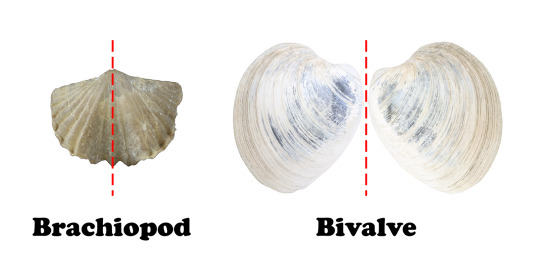


(Sources - 1, 2, 3, 4)
Brachiopoda is a phylum of animals that are superficially similar but entirely unrelated to bivalve molluscs, in that they have hard valves (shells) protecting their bodies. However, unlike bivalves, who have a left and right shell arrangement, brachiopods have upper and lower shells (trust me, it makes sense anatomically). Their shells are hinged at the rear, while the front end can be opened for feeding or closed for protection. Most brachiopods have a stalk-like pedicle which projects from an opening near their hinge and anchors the animal to the sea floor (see 3rd image). Some brachiopods use their pedicle to emerge and retract into a burrow. They are filter feeders, using a lophophore to feed. However, unlike bryozoans and entoprocts, their lophophore is U-shaped. Some species do not have an anus, instead combining solid waste with mucus and periodically "sneezing” it out. Brachiopod lifespans can range from 3 to 30+ years. They only live in the ocean, in areas with cold water and low light, and without strong currents or waves, Some are commonly known as “lamp shells.”
There are two major categories of brachiopod; articulate and inarticulate. Articulate refers to the tooth-and-groove structure at the hinge of the shell, which inarticulate brachiopods lack. Inarticulate brachiopods have larvae that look like miniature adults with extended lophophores (seen in gif below), which live as plankton for months before growing too heavy and sinking to the sea floor. Articulate brachiopods have larvae which look like blobs with a yolk sack and live as plankton for a few days before metamorphosing.
Brachiopods have existed since the early Cambrian, but lost about 2/3 of their once great diversity during the Permian-Triassic extinction event. Today there are about 100 living genera, though there are 5,000 fossil genera.

Propaganda under the cut:
Brachiopods hit their peak in the Paleozoic era, occupying many ecological niches and being the most abundant filter-feeders and reef-builders. After losing most of their diversity in the Triassic, they’ve lost this position to bivalves. But we must never forget the Old Kings of Shell.
The smallest living brachiopod, Gwynia, is only about 1 mm long and lives between grains of gravel.
The largest brachiopods known lived in the Carboniferous: Gigantoproductus and Titanaria could be 30 to 38 cm (12 to 15 in) wide. Today, most brachiopods range from 1 to 100 mm (0.04 to 3.9 in) long, with the largest being Magellania venosa.
Brachiopod flesh is apparently Not That Great, and not much preys on them. Even fossil brachiopods are rarely found with evidence of predation in the same way fossil bivalves are. Humans, however, do fish for one genera commercially, though on a small scale. Because of course we do.
Brachiopods are apparently very sensitive to pollution, and are good indicators of water quality.
Brachiopods are the state fossil of Kentucky. No specific species. Just all of them, I guess.
50 notes
·
View notes
Photo
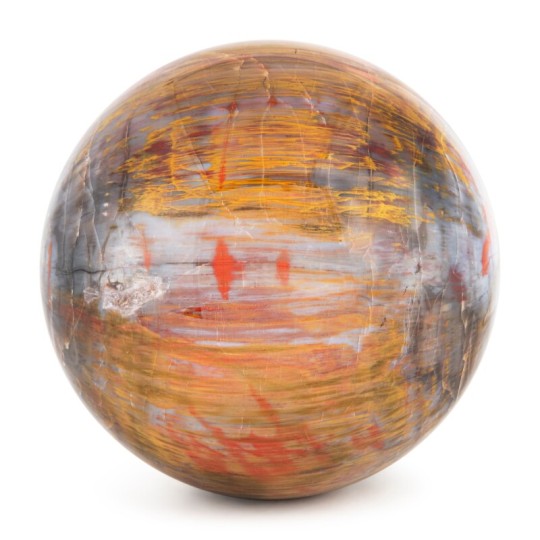
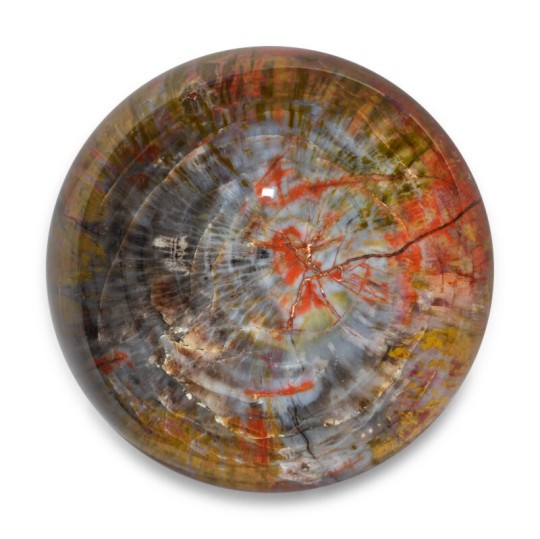
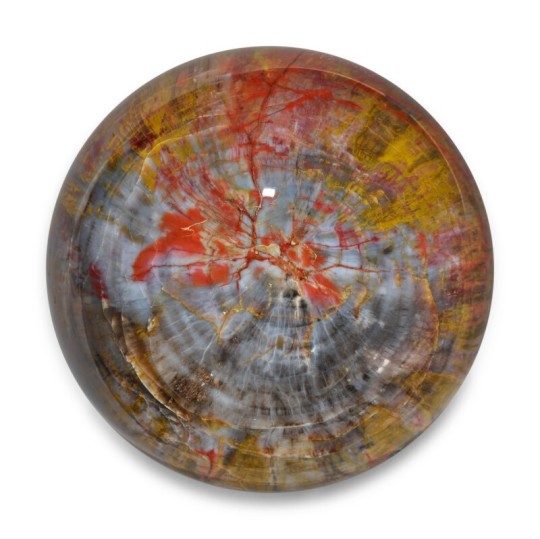

Petrified Wood Sphere Auricarioxylon arizonicum Upper Triassic – 220 million years old Chinle formation, Apache County, Arizona, USA
Finely polished, measuring 8 inches in diameter.
Petrified wood from the famed Chinle Formation near Winslow, Arizona is sometimes referred to as "rainbow wood” due to the large variety of colors which are all naturally produced over time by mineral replacement on a cellular level. Different minerals which seep into the fossilizing wood produce different colors.
In this wondrous example the riot of colors present include orange, yellow, and cream with splashes of blue/grey. Also noteworthy are the well-defined original growth rings, which are a testament to the outstanding preservation.
#Petrified Wood Sphere#Auricarioxylon arizonicum#Upper Triassic#Chinle formation Apache County Arizona#fossil#archeology#archeolgst#pretty#beauty#beautiful#history#history news#ancient history
6 notes
·
View notes
Text
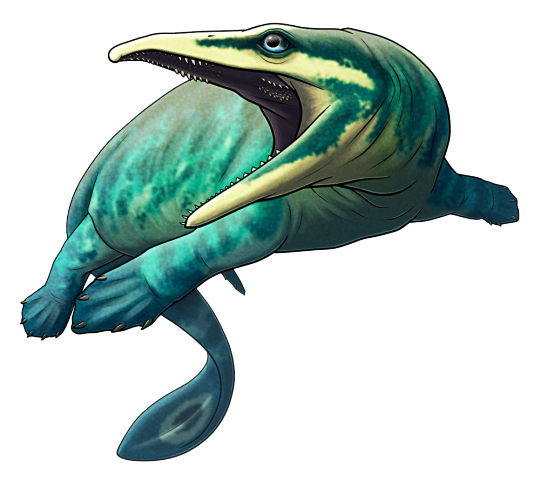
Back in the 1980s, a fossil of a partial reptile skull was discovered in British Columbia, Canada, dating to the Early Triassic about 250 million years ago. Its triangular skull shape, large eye sockets, and what seemed to be distinctive spiky frills on the back of its head initially caused it to be identified as a relative of the gliding weigeltisaurids.
But the aptly-named Wapitisaurus problematicus would have had to be a very unusual member of this group. With an estimated length of up to 2m (6'6") it was much larger than any other known weigeltisaurid, it was the only one known from the Triassic side of the "Great Dying" mass extinction event, it was found in a completely different part of the world, and its teeth seemed more like those of marine reptiles like thalattosaurs.
In recent years new discoveries and re-analysis of weigeltisaurid fossil material have resulted in much better modern understanding of their skull structure – and with that came the realization that Wapitisaurus really didn't seem to match with them after all.
So a new study has finally identified what this problematic reptile really was… and it turns out the teeth didn't lie! It was a marine thalattosaur all along!
Wapitisaurus had rather large eyes compared to most other North American thalattosaurs, and although the front parts of its jaws are missing it probably had a long slightly hooked snout similar to its close relative Thalattosaurus. It's also now one of the oldest known members of the thalattosaur lineage, showing that some of their specialized skull features like retracted nostrils had actually appeared very quickly during their evolutionary history.
…Oh, and those "spiky frills" on the back of Wapitisaurus' skull? They were actually all teeth from both the upper jaw and the palate, on broken shards of bone that had been displaced to just the right spot to muddle up its identity for over three decades.
———
NixIllustration.com | Tumblr | Patreon
#science illustration#paleontology#paleoart#palaeoblr#wapitisaurus#thalattosaur#thalattosauria#neodiapsid#reptile#marine reptile#art#mistaken identity
341 notes
·
View notes
Photo

New dinosaur alert! Presenting Mbiresaurus raathi
Image ID: A digital illustration of the early sauropodomorph dinosaur Mbiresaurus. It is a slender, two-legged dinosaur with a long neck and tail and a body covered in fluffy feathers. The feathers are brown with lighter speckles that turn into stripes on the tail. The head and neck are wrinkled and featherless except for a few long feathers that hang from the base of the neck. The head and neck are coloured with patches of black and white, and an orange lower jaw. The Mbiresaurus is posed in a rough three-quarter view, facing to the right and away from the viewer. The neck is upright and alert, the mouth is slightly open, one foot is raised off the ground and the tail is curved around in front of its legs. End ID.
A newly-described species from Zimbabwe, Mbiresaurus is now the oldest named dinosaur species from Africa! It’s an early sauropodomorph, related to dinosaurs like Eoraptor and Buriolestes, and was probably an omnivore.
Mbiresaurus comes from a new fossil site in Zimbabwe, which contains a whole lot of other species that have yet to be described, including a herrerasaurid, which I’ve represented in this size diagram with Staurikosaurus.
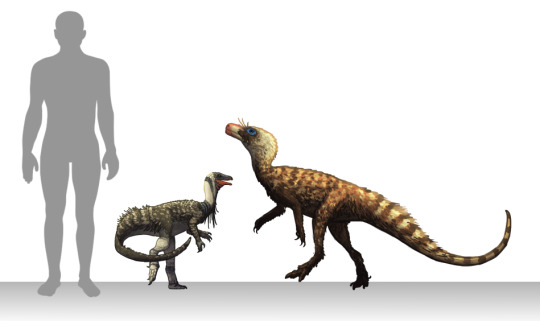
Image ID: A size chart showing Mbiresaurus and the early carnivorous dinosaur Staurikosaurus next to a light grey silhouette of a person. The Mbiresaurus’ head is level with the person’s upper thigh, and the Staurikosaurus’ head comes to approximately waist height. End ID.
The formation also includes a number of synapsid species, a rhynchosaur, and an aetosaur, a group of armoured herbivorous crocodile relatives that had never been found in southern Africa before! When combined together into Pangaea, the location of the fossil site matches the latitude of other Late Triassic early dinosaur sites, suggesting that dinosaurs and other Late Triassic species initially migrated across a similar climatic band that would eventually become South America and southern Africa.
#dinosaurs#paleoart#paleontology#new dinosaur#palaeoblr#mbiresaurus#sauropodomorph#triassic#fossils#prehistoric
597 notes
·
View notes